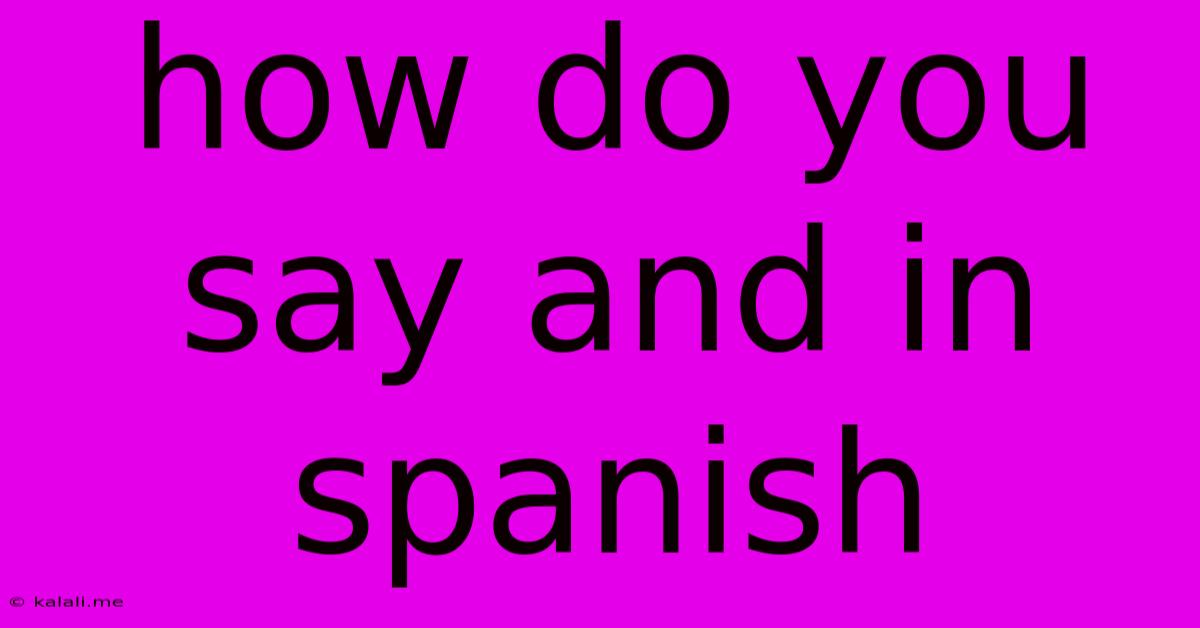How Do You Say And In Spanish
Kalali
May 28, 2025 · 2 min read

Table of Contents
How Do You Say "And" in Spanish? A Comprehensive Guide
So you're learning Spanish, fantastic! One of the first words you'll want to master is "and." While seemingly simple, knowing the nuances of how to say "and" in Spanish will significantly improve your fluency and comprehension. This guide delves into the various ways to express "and" in Spanish, providing context and examples to help you choose the right word in any situation.
This article will cover the most common ways to say "and" in Spanish, including when to use each, and will even touch upon some regional variations. Mastering this seemingly simple word is a crucial step in your Spanish learning journey.
The Main Ways to Say "And" in Spanish
The most common way to say "and" in Spanish is "y." This is the equivalent of "and" in most situations.
- Example: "Pan y queso" (Bread and cheese)
However, Spanish, like English, offers subtle variations depending on context and style. Let's explore some of those:
"E": The "And" for Vowel Connection
While less frequent than "y," "e" is used when connecting two words that begin with a vowel sound. This avoids the awkward repetition of vowel sounds.
- Example: "Agua e hielo" (Water and ice) – Note how using "y" would sound clunky: "Agua y hielo."
"Ni": The "And" for Negation
"Ni" translates to "neither...nor" or "not even." It expresses a negative conjunction.
- Example: "No quiero ni café ni té" (I don't want either coffee nor tea). This showcases its use in connecting two negative elements.
Regional Variations and Informal Speech
While "y" and "e" are standard across most Spanish-speaking regions, some informal variations exist. These are largely colloquial and might not appear in formal writing.
- "Y" can be used in place of "e" and vice versa in casual conversation. While grammatically less precise, it's perfectly understandable.
- Certain dialects may use alternative words or phrases for emphasis, though these are more localized and less frequently used.
Choosing the Right "And" – Context is Key
The key to mastering "and" in Spanish lies in understanding the context. Always consider the words you're connecting:
- Vowel sounds: Use "e" to avoid a harsh vowel combination.
- Negative sentences: Use "ni" to connect two negative elements.
- Formal vs. informal settings: While "y" is universally accepted, "e" is generally preferred in formal writing.
By carefully considering these points, you can confidently select the most appropriate way to say "and" in Spanish, enhancing the natural flow and accuracy of your communication. Remember, practice makes perfect! The more you immerse yourself in the language, the more instinctively you'll choose the correct conjunction.
Latest Posts
Latest Posts
-
How To Remove Front Door Handle
May 30, 2025
-
How To Increase Bike Skill Fast Gta Sa
May 30, 2025
-
Why Is Tyrosine Classified As Phobc
May 30, 2025
-
What Size Aluminum Wire For 100 Amp Sub Panel
May 30, 2025
-
How Long To Do 17 Math Questions
May 30, 2025
Related Post
Thank you for visiting our website which covers about How Do You Say And In Spanish . We hope the information provided has been useful to you. Feel free to contact us if you have any questions or need further assistance. See you next time and don't miss to bookmark.